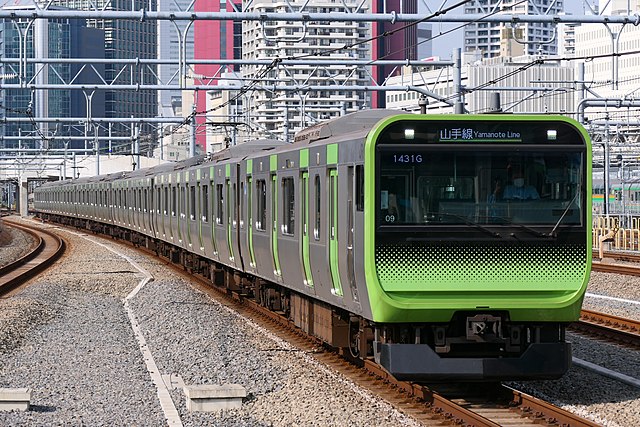Yamanote Line
railway loop line in Tokyo, Japan From Wikipedia, the free encyclopedia
Remove ads
The Yamanote Line (Japanese: 山手線, Hepburn: Yamanote-sen) is a railway line of East Japan Railway Company (JR East) in Tokyo, Japan. It is one of Tokyo's busiest and most important lines, connecting most of Tokyo's big stations and city centres, including Marunouchi, the Yūrakuchō/Ginza area, Shinagawa, Shibuya, Shinjuku, Ikebukuro and Ueno, with all but two of its 29 stations connecting to other railway or underground (subway) lines.
This article has a list of references or other websites, but its sources are not clear because it does not have inline citations. (April 2021) |


As an official line name, "Yamanote Line" is usually meant as a line with tracks between Shinagawa and Tabata from Shinjuku that are used by local trains on its tracks and also the parallel Yamanote Freight Line which is used by Saikyō Line and Shōnan-Shinjuku Line trains, some limited express services, and freight trains. However, in everyday use, the "Yamanote Line" refers to the entire 34.5 km loop line served by local trains. (This article uses the same thing meant except when it is said that it would not be the same meaning meant.)
Remove ads
History
In 1909, The Yamanote Line began service between Shinagawa and Akabane, and it was called the "Shinagawa Line" at that time. A train consisted of 10 cars. The circular line began in 1925. A train schedule 5 trains/hour 72 minutes/a round in 1925, 25 trains/hour 60 minutes/a round in 2014. In 1961, the train color changed from brown to yellow. In 1972, the train color changed from yellow to green. In 1987, Japan Railway was privatized. In 1990, the Yamanote line added one more car to the trains. Wrapping advertisement, using Yamanote Line, has started since 2000. Each station are installing the platform screen doors for the Tokyo Olympics in 2020.
Remove ads
Features
The Yamanote Line has no signal, and a train follows the preceding train. Yamanote Line has not only passenger trains but also freight trains. The Yamanote Line has only one railway crossing. In 2013, 3,238,000 people use Yamanote Line per a day.
Stations
Notes
- 1: Official line names
- 2: Left column is distance from previous station (km) and right column is distance from Shinagawa Station (km).
- 3: "(R)" indicates rapid train stops of the Keihin-Tōhoku Line.
Remove ads
Related pages
References
Wikiwand - on
Seamless Wikipedia browsing. On steroids.
Remove ads
